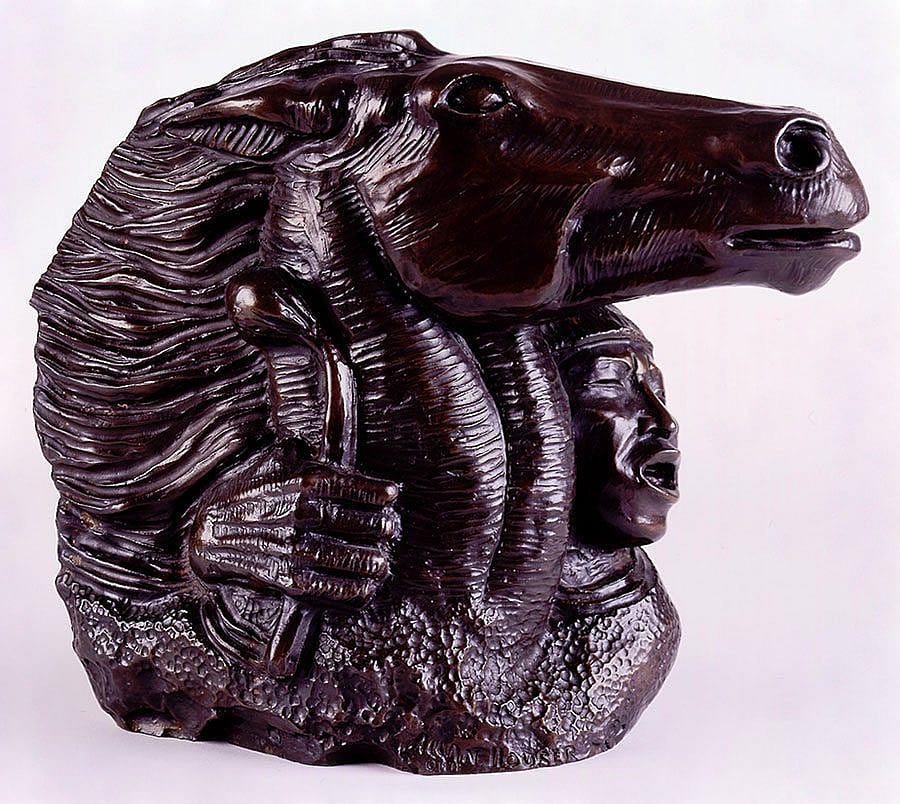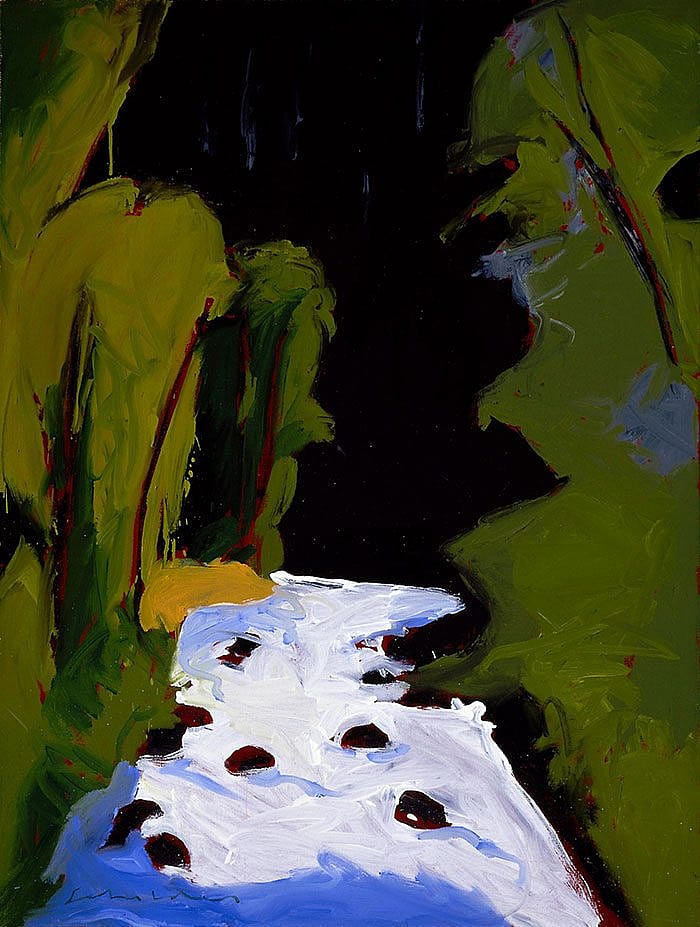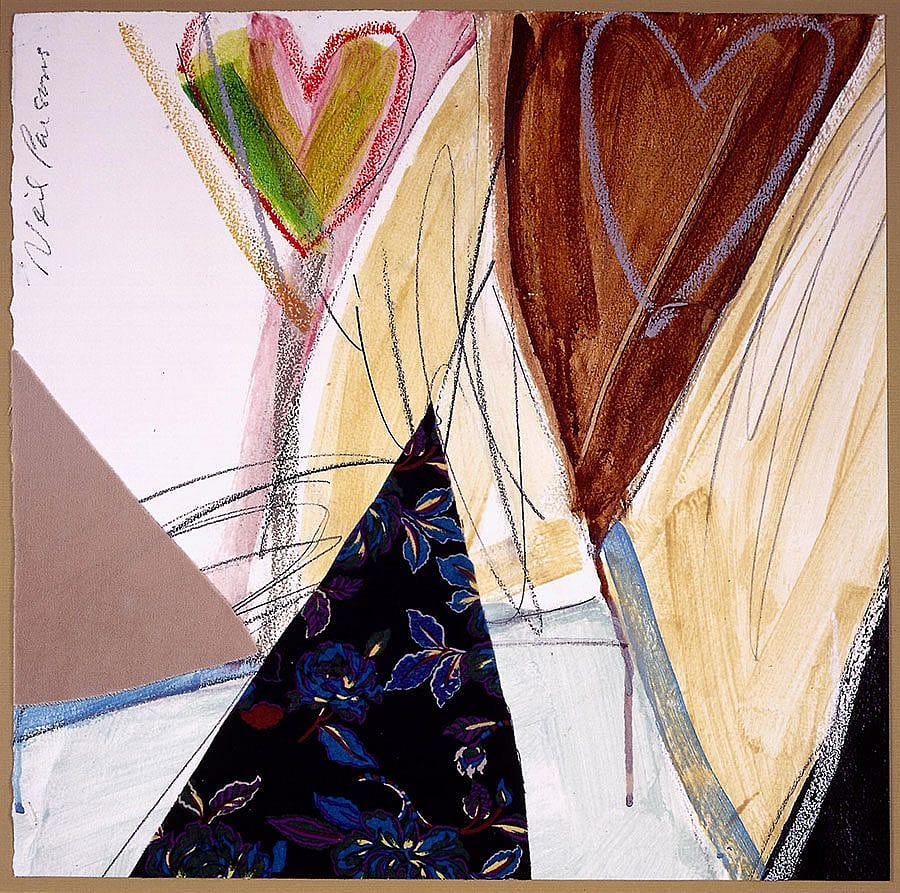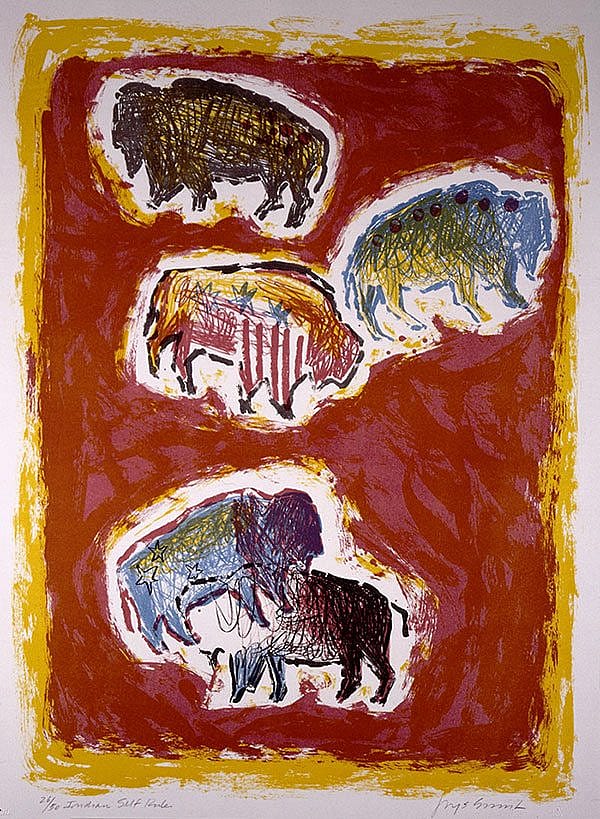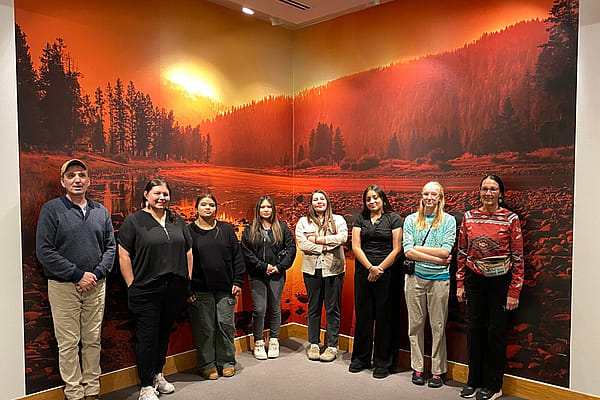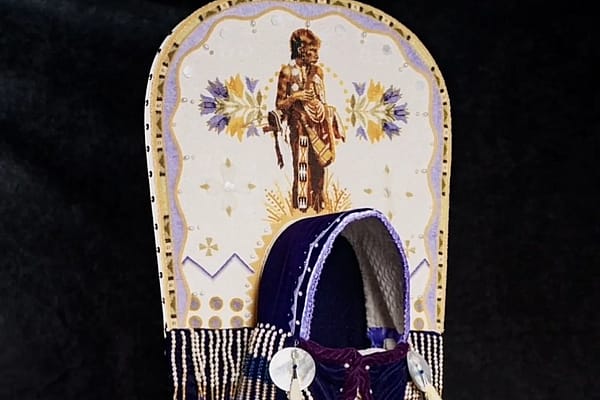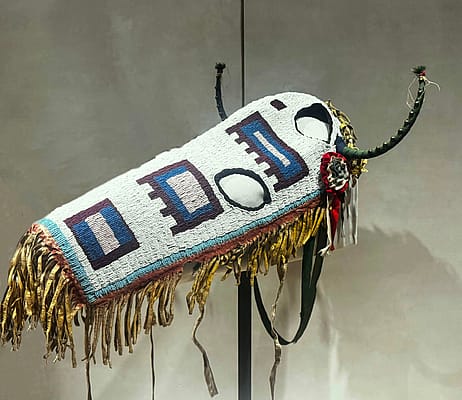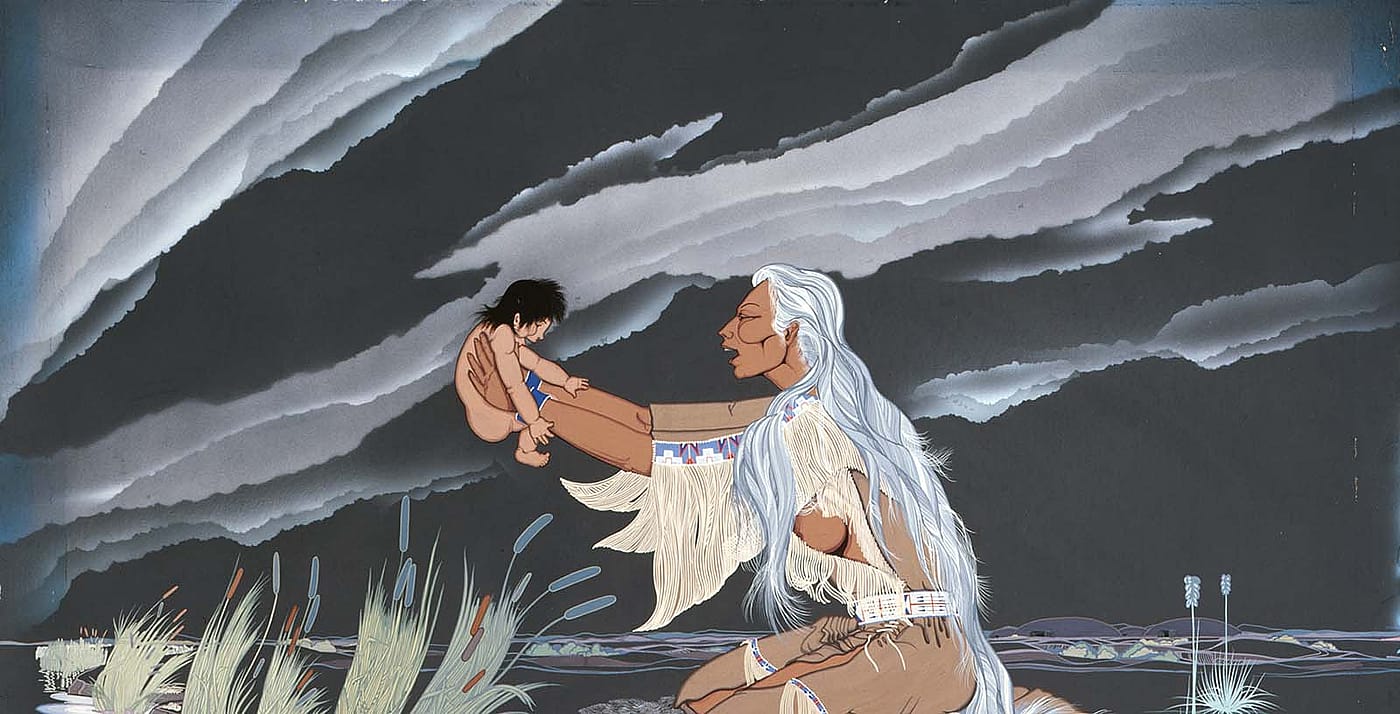
Compelling Issues in Contemporary Indian Art – Points West Online
Originally published in Points West magazine
Summer 2000
Multiple Influences: Compelling Issues Contemporary Indian Art
Sarah E. Boehme
Former Curator, Whitney Western Art Museum
Paintings, sculpture and prints by contemporary Native American artists present some of the most interesting and challenging work being created in the West today. Artists who are Indian often delve into their tribal traditions and yet also find inspiration in artistic movements and styles of the Euro-American culture. Indian artists often incorporate content concerning political, economic, and social issues that confront Native peoples into their art, giving depth and meaning to their productions.
The contemporary scene has been influenced by major changes in Indian art in the twentieth century. In the early decades of the century, several groups of Indian artists developed an approach to painting that used a flat, decorative style to portray scenes of Indian life or aspects of nature. From the Plains tribes came the Kiowa Five and also Lois Smoky in Oklahoma, and from the Southwest developed the similar Studio style of the Santa Fe Indian School. These artists, and the others who were influenced by them, produced paintings for use as visual decoration outside their immediate tribal sphere. Encouraged and instructed by non-native teachers, they found new audiences for their work.
Mandan Mother and Child by Blackbear Bosin (1921–1980) provides an example of this twentieth century movement that is now often called “traditional Indian painting.” Bosin portrays the scene of a mother and child at play with simplified flat shapes, enhanced by lively decorative lines such as the patterning of the mother’s hair and the reeds of the cattails. He portrays the sky and clouds as layers of modulated tones, like pieces of torn paper. Of Comanche-Kiowa heritage, Bosin was self-taught, but was inspired by mural paintings of the Kiowa Five artists. He researched Indian history for his paintings, drawing upon not only his own tribes’ histories but upon others as well. He became especially interested in the Mandan Indians, who had been nearly exterminated by the smallpox epidemic in the 1830s, and he depicted them in a number of paintings such as this one, which includes representations of the Mandan earth lodges at the edge of the horizon.
Allan Houser (1914–1994), who studied at the Studio of the Santa Fe Indian School, began as a painter working in the style of traditional Indian painting. He discovered his affinity for three-dimensional work and became one of the most influential Indian sculptors of the century. A Chiricahua Apache, Houser (or, Haozous, the original form of his name) drew on traditional Indian subject matter, but portrayed his heritage in an abstracted style that has the clarity and directness of the best of modernism. He worked directly in carving, responding to the beauty of stone, and also in modeling for cast bronze. Drama on the Plains, his depiction of the harmony of rider and horse, exists both as an alabaster and as a bronze. Houser had profound influence on the next generation of Indian artists, especially from his role as a faculty member of the Institute of American Indian Arts in Santa Fe from 1962–1973.
The Institute of American Indian Arts, founded in Santa Fe in 1962, represented a new direction in the education of Indian artists. Prior education often was strongly influenced by non-native ideas of what Indian art should be. The Institute instead emphasized efforts of Native artists to determine their own direction. Another influential faculty member of the Institute of American Indian Arts was painter Fritz Scholder (b. 1937).
The paintings of Scholder, who is from Luiseño heritage, herald the strong entrance of a modernist vocabulary. Scholder’s style developed from academic study in which he was exposed to modernist views and he incorporated an expressionist approach, using bold colors and slashing brushstrokes. He at first resisted the idea of portraying Indians because he felt that the Indian had become a “visual cliché.” He then determined to confront the romanticized view of the Indian by painting a series that would look at the Indian in new ways. Over the next years he painted the Indian, often as a contemporary figure, sometimes with humor, sometimes with anger.
Scholder has also made a point of continuing to paint non-Native subjects, such as his representations of mystery women, Egyptian themes, and landscapes, providing a reminder that the artist who is Indian need not be confined only to Indian subjects. Scholder’s Aspen Summer is painted with his signature style of active brushwork and rich, but often dark, coloration.
Indian artists who use twentieth century styles or materials in conjunction with Native approaches bring new sensibilities to their art. Arthur Amiotte, (b. 1942) uses the technique of collage, adding bits of paper to his compositions, a method originated by early twentieth century modernist painters in France.
Amiotte adopts this method as one of the ways he explores the changing worldviews of his people, the Lakota, around the turn of the century, as in The Visit. Amiotte sets the collage elements within a pictorial plane that also draws upon the historic Plains Indian ledger style of representing the figure and providing a narrative history, thus creating a work that comments upon history from the contemporary vantage point.
A Blackfeet artist, Neil Parsons (b. 1938) also uses the collage method, in works such as A Grandmother Lodge. His creations, which use fabric and paper, appear abstract and almost completely non-representational. Yet his titles often suggest a content influenced by his tribal history and his works remind the viewer of the long tradition of abstract designs in traditional Native arts.
The economic, political and social histories of Indian peoples have influenced the subjects of many contemporary artists. Five Indian artists contributed prints to the Indian Self-Rule portfolio, a project that commemorated the fifty-year anniversary of the Indian Reorganization Act of 1934.
Artist Jaune Quick-To-See Smith (b. 1940), who is from Flathead, Cree and Shoshone ancestry and who often addresses social issues in her art, made the lithograph Five Buffalo. According to the portfolio’s Colophon (notation about production) her print “represents Indian attempts to achieve self-rule during the past five decades. The colors are also evocative and symbolic, with yellow representing tanned hide, red for ochre or ‘Indian red,’ black for smoke or charcoal from fire, while blue is used effectively in the ‘stars and stripes.'”
The multiplicity of influences and the compelling sense of issues to be addressed in art are some of the factors that have strengthened the contributions of contemporary artists who are Indian. This brief look has only touched on a few artists as examples and has included works that are in the collections of the Buffalo Bill Center of the West. It points to the need for additional study and additional collecting activity as the Center continues to assess the contributions of contemporary artists.
Post 146
Written By
Nancy McClure
Nancy now does Grants & Foundations Relations for the Center of the West's Development Department, but was formerly the Content Producer for the Center's Public Relations Department, where her work included writing and updating website content, publicizing events, copy editing, working with images, and producing the e-newsletter Western Wire. Her current job is seeking and applying for funding from government grants and private foundations. In her spare time, Nancy enjoys photography, reading, flower gardening, and playing the flute.


